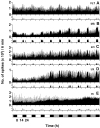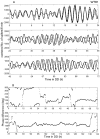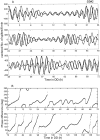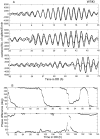Rhythmic properties of the hamster suprachiasmatic nucleus in vivo
- PMID: 9852606
- PMCID: PMC6793356
- DOI: 10.1523/JNEUROSCI.18-24-10709.1998
Rhythmic properties of the hamster suprachiasmatic nucleus in vivo
Abstract
We recorded multiple unit neural activity [multiunit activity (MUA)] from inside and outside of the suprachiasmatic nucleus (SCN) in freely moving male golden hamsters housed in running-wheel cages under both light/dark cycles and constant darkness. The circadian period of MUA in the SCN matched the period of locomotor activity; it was approximately 24 hr in wild-type and 20 hr in homozygous tau mutant hamsters. The peak of MUA in the SCN always occurred in the middle of the day or, in constant darkness, the subjective day. There were circadian rhythms of MUA outside of the SCN in the ventrolateral thalamic nucleus, the caudate putamen, the accumbens nucleus, the medial septum, the lateral septum, the ventromedial hypothalamic nucleus, the medial preoptic region, and the stria medullaris. These rhythms were out-of-phase with the electrical rhythm in the SCN but in-phase with the rhythm of locomotor activity, peaking during the night or subjective night. In addition to circadian rhythms, there were significant ultradian rhythms present; one, with a period of approximately 80 min, was in antiphase between the SCN and other brain areas, and another, with a period of approximately 14 min, was in-phase between the SCN and other brain areas. The periods of these ultradian rhythms were not significantly different in wild-type and tau mutant hamsters. Of particular interest was the unique phase relationship between the MUA of the bed nucleus of the stria terminalis (BNST) and the SCN; in these two areas both circadian and ultradian components were always in-phase. This suggests that the BNST is strongly coupled to the SCN and may be one of its major output pathways. In addition to circadian and ultradian rhythms of MUA, neural activity both within and outside the SCN was acutely affected by locomotor activity. Whenever a hamster ran on its wheel, MUA in the SCN and the BNST was suppressed, and MUA in other areas was enhanced.
Figures















References
-
- Bendat JS, Piersol AG. Random data: analysis and measurement procedures, 2nd Edition, pp 484–516. Wiley; New York: 1986. The Hilbert transform.
-
- Bergman H, Feingold A, Nini A, Raz A, Slovin H, Abeles M, Vaadia E. Physiological aspects of information processing in the basal ganglia of normal and Parkinsonian primates. Trend Neurosci. 1998;21:32–38. - PubMed
-
- Bos NPA, Mirmiran M. Circadian rhythms in spontaneous neuronal discharges of the cultured suprachiasmatic nucleus. Brain Res. 1990;511:158–162. - PubMed
-
- Davies IR, Mason R. Tau-mutant hamster SCN clock neurons express a 20 h firing rate rhythm in vitro. NeuroReport. 1994;5:2165–2168. - PubMed
-
- Dietl H, Prast H, Philippu A. Pulsatile release of catecholamines in the hypothalamus of conscious rats. Naunyn Schmiedebergs Arch Pharmacol. 1992;347:28–33. - PubMed
Publication types
MeSH terms
Substances
Grants and funding
LinkOut - more resources
Full Text Sources
Medical
Miscellaneous
